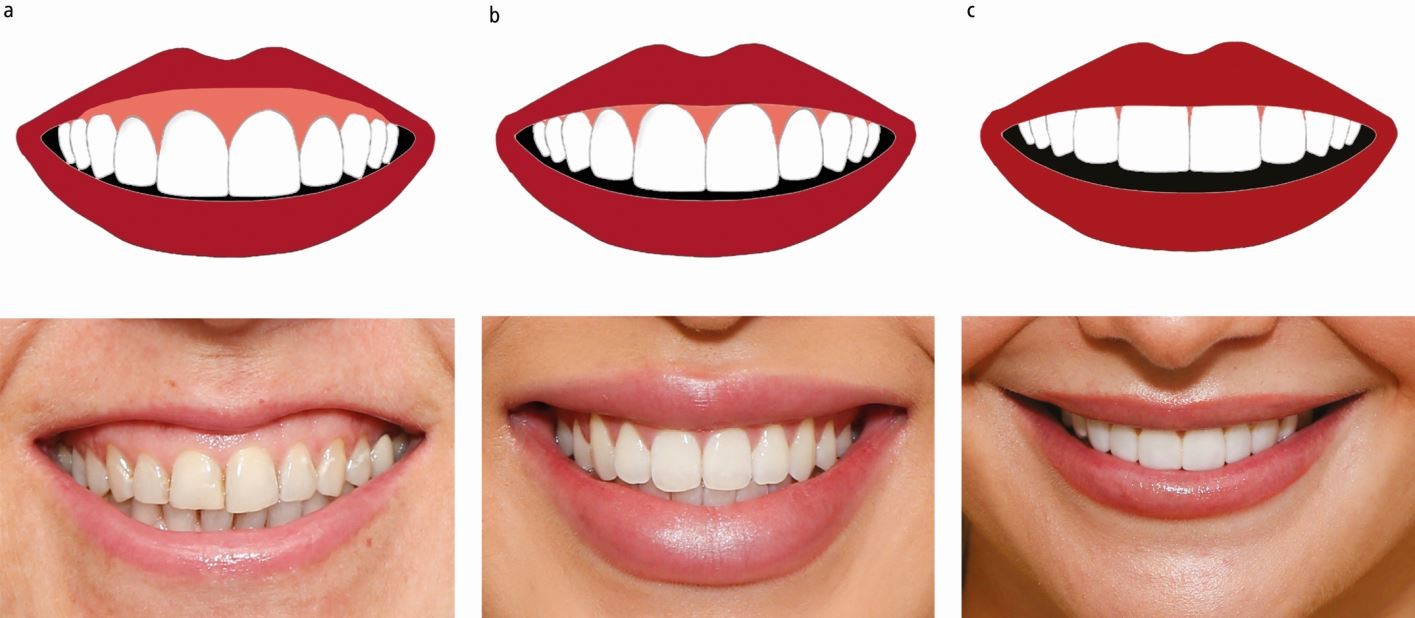- By - Malfaifi
- Posted on
- Posted in Diagnosis, Fixed, Prosthesis
Smile aesthetics
Some esthetic factors in a smile
Tjan et al 1984

The smile is one of the most important facial expressions and an esthetic smile can enhance an individual’s acceptance into society by improving initial impressions and interpersonal relationships.
Beauty is not absolute, it is extremely subjective and can be dictated by cultural factors and individual preferences.
In order to achieve optimum results in oral rehabilitation, this study attempts to describe some desirable characteristics of a smile with regards to
(1) smile type (high, average, low)
(2) parallelism of the maxillary incisal curve with the lower lip
(3) position of the incisal curve relative to touching the lower lip
(4) the number of teeth displayed in a smile.
Materials and Methods:
A comparative analysis of the characteristic dental and facial features of esthetic smiles was conducted with 454 full-face photographs of dental and dental hygiene students with open smiles (smiles displaying teeth).
The subjects were 207 men and 247 women from 20 to 30 years of age.
Each subject was compared, analyzed, and evaluated by careful visual judgment rather than by mathematical measurements.
To minimize possible evaluator preferences the data was analyzed independently. Differences between smile type and parallelism of the maxillary incisal curve relative to touching the lower lip were determined statistically with z scores.
Definition of terms
Open smiles were divided into three categories.
High smile (S1): Reveals the total cervicoincisal length of the maxillary anterior teeth and a contiguous band of gingiva.
Average smile (S2): Reveals 75% to 100% of the maxillary anterior teeth and the interproximal gingiva only.
Low smile (S3): Displays less than 75% of the anterior teeth.
Results:
Smile Type: 48 subjects (10.57%) had a high smile line, 313 (68.94%) had an average smile line, and 93 (20.48%) had a low smile line.
The differences in smile type were statistically significant between men and women.
Parallelism of the maxillary incisal curve with the lower lip: 385 subjects (84.8%) showed parallelism, 63 (13.88%) showed a straight smile line, and 6 (1.32%) showed a reverse smile line.
The differences between men and women were statistically insignificant.
Position of the incisal curve relative to touching the lower lip: 192 (46.61%) subjects’ maxillary anterior teeth were touching the lower lip (C1), 134 (34.62%) were not touching the lower lip (C2), and in 61 (15.76%) subjects the incisal portions of the anterior teeth were covered the lower lip (C3).
There were significant differences between men and women in groups Cl and C2, but not in C3.
Number of teeth displayed in a smile: 6 anteriors only 7.01%; 6 anteriors and first premolars, 48.6%; 6 anteriors and first and second premolars, 40.65%; 6 anteriors, first and second premolars, and first molars, 3.74%.
A typical or average smile has the following characteristics:
1. The overall cervicoincisal lengths of the maxillary anterior teeth are displayed.
2. Gingiva does not show (except the interproximal gingiva).
3. The incisal curvature of the maxillary anterior teeth parallels the inner curvature of the lower lip.
4. The incisal curvature may be either totally touching or slightly touching the lower lip.
5. The six maxillary anterior teeth and the first or second premolars are displayed.
6. The midline coincides with a harmonious balance of the smile.
7. Stereotyped “feminine” and “masculine” tooth anatomy characteristics could not be related to the sample.
Conclusions
Findings show that an average smile exhibits approximately the full length of the maxillary anterior teeth, has the incisal curve of the teeth parallel to the inner curvature of the lower lip, has the incisal curve of the maxillary anterior teeth touching slightly or missing slightly the lower lip, and displays the six upper anterior teeth and premolars.
Consideration of the characteristics may be useful in improving the esthetics of restorations.



